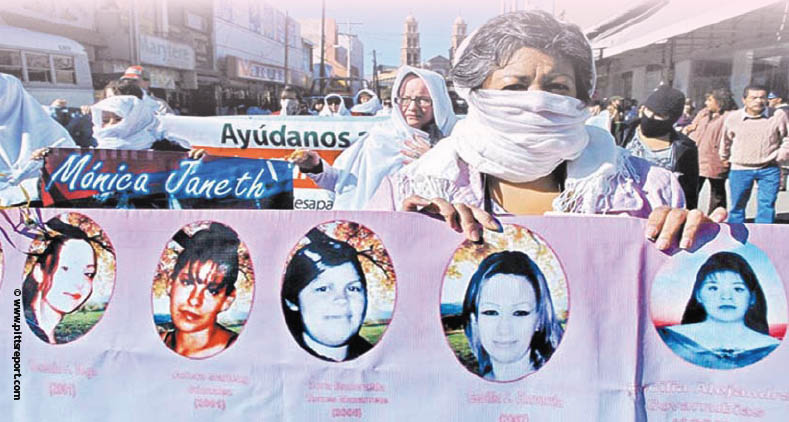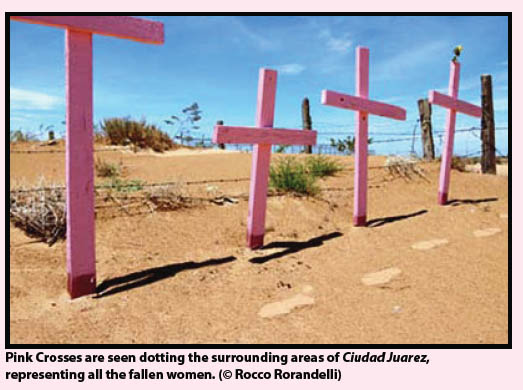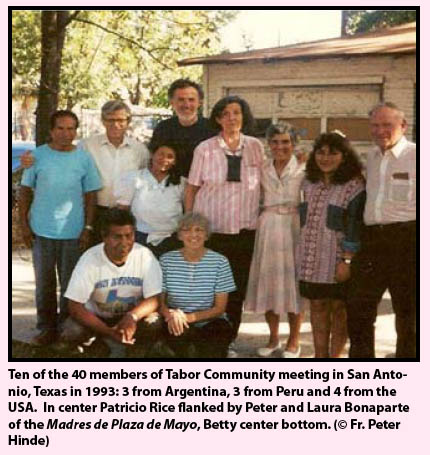Ciudad Juarez, Mexico: Laboratory of the Future
by Peter C. Hinde, O.Carm.
Family and friends of Nubia Valencia Rodriguez and two other women
friends of Casas Grandes were disappeared on 18 August. In broad
daylight, the three went for a drive in the immediate area of this small
town just outside Juarez. Three of thousands, they have not been heard
of since.

Background
Forced disappearances in Mexico escalated in 1968 when the army and
paramilitary slaughtered scores of people in a student protest at the
heart of Mexico City, their bodies trucked to some destination and never
revealed. Some were captured alive and disappeared. In 1972, another
military operation captured and disappeared people accused of belonging
to an armed insurgency.
Rosario Ibarra de Piedra’s son was taken in this latter operation. In
response, she founded Eureka as a movement of families of some five
hundred people to protest disappearances. Since then, such
disappearances were of scattered instances through the years, but
without any government response to those registered with Eureka. Private
investigations have identified the commanders and government officials
in charge of those operations. With overwhelming evidence, ex-President
Luis Echeverria was charged and tried in 2006, but ironically, charges
were dismissed for “lack of evidence.”
In 1994, Esther Chavez Cano, owner of a women’s apparel business, began
to take notice of the killings and disappearances of young women in
Juarez. She wrote a column in the principal daily, El Diario de
Juarez, to denounce these crimes, By 1999, she had sold her business
and opened Casa Amiga to register such crimes against women. She
hired a lawyer and psychologists to assist victims of abuse and families
in search of loved ones. Casa Amiga became an effective
institution.
Several movements were started by families of the disappeared. Early on,
Sra. Judith Galarza of Juarez, whose sister had been disappeared,
initiated a group. After a few years, she headed a group in the Federal
District that related to the Latin American Federation of Associations
of Relatives of Disappeared Detainees (FEDEFAM). From 2001,
Judith has headed up FEDEFAM from Caracas, Venezuela.
The challenge to the government by Casa Amiga and these other
organizations in Juarez to find, arrest and punish the culprits was met
with indifference and at times cynicism. Support through the 1990s grew
in Mexico and in border cities in the USA with demonstrations of a size
that forced media attention. It was the disappearance of men that first
drew international attention.

“We have much work left to do, the road ahead is long and hard. There
will come a time when my voice becomes silent so that new voices can be
heard to carry on the struggle for the rights of women, which, as I have
said, is also for the rights of men, because it is the struggle for a
more just and democratic society for all.”
Esther Chavez Cano, 9 November 2007
Jaime Hervella, a business consultant in El Paso, searched for his
godson and wife who disappeared in Juarez in 1994. In time, Hervella
discovered other families in Juarez on the same search. In 1997, he
organized a press conference in El Paso with some 60 people from Juarez
and a reporter from the New York Times. That meeting revealed that 55
men, a number soon set at 189, had been disappeared in Juarez, and thus,
was born the Association of Families of Men Disappeared in Juarez. Over
the years, with publicity, Hervella forced a succession of inspection
teams from the Federal government to come to Juarez, but each proved
fruitless. Families grew tired of the interminable run-around by
officials of government, but continued to educate the public and use the
media.
However, the government of Japan expressed to the government of Mexico
its alarm at the news in the front page article in the New York Times.
They feared for the managers of their maquila industries in Tijuana at
the US border. As the case of disappeared men hit the international
news, the situation of the women in Juarez did also.
Moreover, Laura Bonaparte of the Madres de Plaza de Mayo of Argentina
visited the families in Juarez to stress with them the need to go to
Amnesty International, to her own Madres de Plaza de Mayo, and the
Organization of American States (OAS) Human Rights Commission in Costa
Rica to garner international legal support. The killing of women in
Juarez was an atrocious crime that, to date, has reached over 1000 and
the number of disappearances is calculated in the thousands. Men were
being killed at eight and ten times the number of women.
The number of killings due to the incipient drug war in the 1990s was
another factor to reckon. By the year 2000, the government’s failure to
solve these crimes convinced many that there was complicity from within
the government. So often, the army or the federal police stood by while
Narco gunmen shot down supposed opponents and many innocent civilians.
The lack of prosecution of crimes created a situation of impunity and an
invitation for anyone with criminal intent.
The downturn of the US economy in 2007-2008 resulted in sudden
unemployment in Mexico. In the meantime, Juarez had become not only a
point of crossing drugs to the US, but of drug consumption, an
additional prize for the drug gangs. Extortion and kidnapping for ransom
have now become common. The killing escalated this summer to 300 per
month.
Confusion Reigns… Government Inept, Officials Complicit… ”Forced”
Disappearances?
It is a question of whether or not the disappearance of Nubia Valencia
could be registered as a “forced disappearance.” The current drug war
has occasioned many to be disappeared by the several cartels vying for
control of drug routes. If the person recovers their liberty, they are
silent about their captors for fear of reprisals. “Narcos” have bought
the collaboration of officials of government at every level. When
kidnapping is done by officials of government in collusion with a
cartel, the threat is double.
 The
result is that much confusion reigns, as in this case of Nubia Valencia,
as to what agency is responsible for her disappearance. In recent years,
there are many cases of government agents or “narcos” clearly
identified, for kidnappings are done by the army, narcos, police and
paramilitary. An army patrol entered a house to take two young men. They
terrorized the other members of the family and in broad daylight, led
the two to a vehicle with other soldiers. Their tortured bodies were
found three days later outside the city.
The
result is that much confusion reigns, as in this case of Nubia Valencia,
as to what agency is responsible for her disappearance. In recent years,
there are many cases of government agents or “narcos” clearly
identified, for kidnappings are done by the army, narcos, police and
paramilitary. An army patrol entered a house to take two young men. They
terrorized the other members of the family and in broad daylight, led
the two to a vehicle with other soldiers. Their tortured bodies were
found three days later outside the city.
In March 2008, when President Calderon sent a detachment of 2,000
soldiers, the mayor of Juarez ceded authority for security to the
General. The police, under the authority of the army command, was
purged: 300 of 1,500 police were dismissed and new recruits trained. In
Tijuana, in Baja California, the whole police force was replaced. Of
course, the police, now unemployed, feed the ranks of the “narcos.” The
“narcos” now have cadres better trained than the army and have
equivalent weaponry. Fed intelligence about army moves, they can choose
their time and place for ambushes.
 At
the turn of the century in the state of Tamaulipas, the Gulf Cartel
managed to attract almost a whole company of soldiers, many trained as
Special Forces in the U.S, with wages many times better than what they
received in the army. Named the Zetas, they grew to such strength both
in number and weaponry that some years later, they split from the Gulf
Cartel to form their own and then terrorize the whole of the state of
Taumalipas and the neighboring state of Nuevo Leon as they attack their
former allies, police, and the army. They exercise violent influence in
many other states along the drugs routes.
At
the turn of the century in the state of Tamaulipas, the Gulf Cartel
managed to attract almost a whole company of soldiers, many trained as
Special Forces in the U.S, with wages many times better than what they
received in the army. Named the Zetas, they grew to such strength both
in number and weaponry that some years later, they split from the Gulf
Cartel to form their own and then terrorize the whole of the state of
Taumalipas and the neighboring state of Nuevo Leon as they attack their
former allies, police, and the army. They exercise violent influence in
many other states along the drugs routes.
Since 2008, extortion for protection money has become common all along
the border. The same is also true for kidnapping for ransom. If the
money is not given, the business will be attacked or a relative killed
or kidnapped. This year, the calculation is that there are 200
kidnappings a month in the one state of Taumalipas. Many business and
medical doctors have shut down their business or clinics and moved over
to the US side. Just in Juarez, the estimates range from 60,000 to
100,000. Others flee the city to the south back into the interior of
Mexico. The official population of 1.3 million has been reduced to one
million over the past three years.
Laboratory of Our Future
The financial melt-down in the US immediately affected the maquila
industries in Juarez with 90,000 jobs lost in that year. In that sector
of Juarez, where the larger maquila industries are located, only one
killing has been reported. 60% of the industry seemingly keeps operating
normally. Even with the escalating violence, over the last year, there
has been a slight recovery in the industry. The capitalist logic of
seeking out cheap labor continues to operate, the depression an excuse
to keep wages even lower.
Even though the crime occurs in broad daylight and in public places,
there are no witnesses. Nobody sees anything. Everyone fears reprisals.
For journalists and editors in many smaller towns in the north, it is
impossible to publish news of the violence. One editor said that it is
even dangerous to know. You have to pretend that you know nothing,
otherwise, you are in danger. Ten journalists or media people have been
killed just this year.
Curiously, after the detachment of soldiers arrived in Juarez in 2008,
the killings increased that year to four times the previous year, then
to the unheard of 1,608 in 2008. In 2009, President Calderon sent
another 5,000 troops plus 2,000 Federal police and the killing increased
to 2,700. In the year 2010, it is set to surpass that figure (by years
end 3,111). In the month of August, it reached 336. Despite or because
of the presence of army and Federal Police, impunity reigns.
Recently, there have been many cases of disappeared people who were
politically active in opposition to the government in states like,
Oaxaca, Guerrero, Chiapas where military repression of popular movements
was done at the orders of the governors. In Juarez, the heavily migrant
population is fragmented and difficult to organize. There is no
significant popular movement here in Juarez.
Efforts to organize movements to demand investigation, apprehension of
criminals have not been absent, but with little result. The present
neo-liberal economy with its “race-to-the bottom” for ever lower wages
has created the present day Juarez. The so-called Free Trade Agreements
have impoverished Mexico’s working class and made education and health
service a luxury. Forty percent of youth from 13 to 20 are neither
studying nor employed, an ideal recruitment base for the drug cartels.
We are forced to ask if the title of a photojournalist’s book published
in 2000 is prophetic. The story Charles Bowden depicts shows the poverty
of Juarez, the dead bodies in the streets or in the outskirt desert. It
does not and cannot show the disappeared. He points to a future for any
economy based on the neoliberal model.
At the moment when the eyes of the world are focused here, “Jaurez,
the Laboratory of Our Future,” is a title that is a warning for the
world.


Peter C. Hinde, priest of the Carmelite Order, following missionary work
in Peru, in 1973 with Mercy Sister Betty Campbell founded Tabor House
Community in Washington, D.C. to do reverse mission to the US and
solidarity work with Latin America. As close friends of Patricio Rice
when Patricio belonged to the Tabor Community (1978-79), they developed
special concern for the detained-disappeared. They continue the same
work for the past 15 years in Ciudad Juarez.